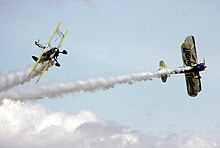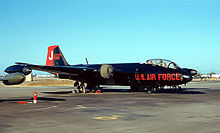User:Mbcannell/sandbox



'Aerobatics is the demonstration of flying maneuvers for training, recreation or entertainment.
Definition=
[edit]International regulatory bodies such as the the Federal Aviation Administration (FAA) or Cival Aviation Authorities of Australia, New Zealand and the U.K. define aerobatic flight as an intentional maneuver involving an abrupt change in an aircraft's attitude, an abnormal attitude or abnormal acceleration, not necessary for normal flight [1]. [2] In addition, FAA rule part 91.307 states that a pilot should not intentionally fly at high angles of bank (>60 degrees) or with large pitch (>30 degrees) unless each occupant is wearing an approved parachute [3]. Such maneuvers can lead to the aircraft carrying out up to 360 degree rotation about its longitudinal axis (rolling) or in the pitch axis (looping) which form the basis of many aerobatic maneuvers. Some complex maneuvers, such as spinning, also require that the aircraft rotate around the vertical axis, known as yawing. Maneuvers are often combined to allow the aircraft to complete aerobatic sequences that may be judged in competitions or entertain the public. Aerobatic flying requires a higher set of piloting skills than for normal flight, exposes the aircraft to greater structural stress and carries a risk for the pilot who must combat disorientation and g forces. Many pilots fly aerobatics solely for recreation, but world-wide, several hundred pilots choose to fly in aerobatic competitions.
Overview
[edit]In the early days of flying, some pilots used their aircraft as part of a flying circus to entertain. Maneuvers that had no practical purpose were flown for artistic reasons or to draw gasps from onlookers. In due course some of these maneuvers were found to allow aircraft to gain tactical advantage during aerial combat or dogfights between fighter aircraft.
Aerobatic aircraft usually fall into two categories—specialist aerobatic, and aerobatic capable. Specialist designs such as the Pitts Special, the Extra 200 and 300, and the Sukhoi Su-29 aim for ultimate aerobatic performance. This comes at the expense of general purpose use such as touring, or ease of non aerobatic handling such as landing. At a more basic level, aerobatic capable aircraft, such as the Cessna 152 Aerobat model, can be dual purpose—equipped to carrying passengers and luggage, easy to land, as well as being capable of basic aerobatic figures.
Flight formation aerobatics are flown by teams of up to sixteen aircraft, although most teams fly between four and ten aircraft. Some are state funded to reflect pride in the armed forces whilst others are commercially sponsored. Coloured smoke trails may be emitted to emphasise the patterns flown and/or the colours of a national flag. Usually each team will use aircraft similar to one another finished in a special and dramatic colour scheme, thus emphasising their entertainment function. Teams often fly V-formations—they will not fly directly behind another aircraft because of danger from wake vortices or engine exhaust. Aircraft will always fly slightly below the aircraft in front, if they have to follow in line.
Aerobatic maneuvers flown in a jet powered aircraft are limited in scope as they cannot take advantage of the gyroscopic forces that a propeller driven aircraft can exploit. Jet powered aircraft also tend to fly much faster which increases the size of the figures and the length of time which the pilot has to withstand increased g-forces. Jet aerobatic teams often fly in formations which further restricts the maneuvers that can be safely flown.
Training
[edit]Aerobatics are taught to military fighter pilots as a means of developing precise flying skills and for tactical use in combat. Aerobatics and formation flying is not limited solely to fixed wing aircraft, helicopters are also used—the British Army, Royal Navy, Spanish Air Force and the Indian Air Force, among others, have helicopter display teams. All aerobatic maneuvers demand training and practice to avoid accidents. Such accidents are rare but can result in fatalities; safety regulations are such that there has not been an airshow spectator fatality in the USA since the 1950s. Low-level aerobatics are extremely demanding and airshow pilots must demonstrate their ability before being allowed to gradually reduce the height at which they may fly their show.
There are many aerobatic training schools in the U.S. and other countries. A detailed list is available at http://www.iac.org/begin/schools.html

Competition
[edit]Competitions start at Primary, or Graduate level and proceed in complexity through Sportsman, Intermediate and Advanced, with Unlimited being the top competition level. Experienced aerobatic pilots have been measured to typically pull +/-5g for short periods while unlimited pilots can perform more extreme manoeuvres and experience higher g levels -possibly up to +8/-6g [4]. The limits for +ve g are higher than for -ve g and this is due to the ability to limit blood pooling for positive g manoeuvres, but it is generally accepted that +9 g for more than a few seconds will lead to loss of consciousness (also known as GLOC).[4][5]
Performance
[edit]Aerobatics are most likely to be seen at a public airshows. Famous teams include:
- Asas de Portugal (Portuguese Air Force)
- August 1st (People's Liberation Army Air Force)
- Black Eagle (Republic of Korea Air Force)
- Blue Angels (United States Navy)
- Blue Diamonds (Philippine Air Force)
- Blue Eagles (Army Air Corps—United Kingdom)
- Blue Impulse (Japan Air Self-Defense Force)
- Cartouche doré (French Air Force)
- Cruz del Sur ("Southern Cross"—Argentine Air Force)
- Diables Rouges (Belgian Air Force)
- Elang Biru (Indonesian Air Force)
- Frecce Tricolori (Italian Air Force)
- Halcones (Falcons-Chilean Air Force)
- Green Hawk (Bureau of Royal Rainmaking and Agricultural Aviation, Thailand)
- Midnight Hawks (Finnish Air Force)
- Orlik Aerobatic Team, White-Red Sparks (known also as Team Iskry), Scorpion (aerobatic team) (Polish Air Forces)
- Patrouille de France (French Air Force)
- Patrouille Suisse (Swiss Air Force)
- Patrulla Aguila, Patrulla Aspa (Eagle Patrol; Blade Patrol—Spanish Air Force)
- Red Arrows (Royal Air Force—United Kingdom)
- Red Checkers (Royal New Zealand Air Force)
- Red Pelicans, Rothmans, Silver Falcons (South African Air Force)
- Rotores de Portugal (Portuguese Air Force—Helicopters)
- Roulettes (Royal Australian Air Force)
- Royal Jordanian Falcons (Royal Jordanian Air Force)
- Black Knights, Republic of Singapore Air Force
- Russian Knights, Strizhi (Swifts), Rus (Russian Air Force)
- Sagar Pawan (Indian Navy)
- Sanmueang (Royal Thai Air Force)
- Sarang (Indian Air Force)
- Saudi Hawks, (Royal Saudi Air Force)
- Sherdils (Pakistan Air Force)
- Silver Falcons (South African Air Force)
- Silver Swallows Irish Air Corps
- Esquadrilha da Fumaça Brazilian Smoke Squadron
- Snowbirds (Canadian Armed Forces)
- Surya Kiran (Indian Air Force)
- Team Jupiter (Indonesian Air Force)
- Team 60 (Swedish Air Force)
- Thunder Tiger (Republic of China)
- Thunderbirds (United States Air Force)
- Turkish Stars (Türk Yıldızları) (Turkish Air Force)
- Ukrainian Falcons (Ukrainian Air Force)
Former teams
[edit]

- Yellowjacks (UK, RAF)
- Black Arrows (No. 111 Squadron RAF, 1950s)
- Blue Herons display team (UK, Royal Navy, FRADU)
- Blue Diamonds (No. 92 Squadron RAF)
- The Tigers (No. 74 Squadron RAF)
- The Firebirds (No. 56 Squadron RAF)
- The Red Pelicans (UK, RAF)
- Simon's Sircus (UK, Royal Navy, Fleet Air Arm)
- Fred's Five (UK, Royal Navy, Fleet Air Arm)
- The Red Knight (Royal Canadian Air Force)
- The Goldenhawks (Royal Canadian Air Force)
- Golden Centennaires (Royal Canadian Air Force)
- Acrojets (USAF Fighter School at Williams Air Force Base, Arizona 1949-1950)
- Acrojets (USAFE at Fürstenfeldbruck AB, Germany in the mid-1950s)
- Skyblazers (USAFE at Fürstenfeldbruck AB, Germany from late 1940s to 1962)
- The Black Knights (38th Tactical Bombardment Wing, USAFE, 1950s)
- Flying Jokers (Squadron 332, Royal Norwegian Air Force)
See also
[edit]- Aerobatics (radio-controlled aircraft)
- Air racing
- Aresti Catalog
- Competition aerobatics
- Flight dynamics
- Flypast
- HASELL
- Aerobatic maneuver
- Aero GP
- Aerobatic pilots
Notes
[edit]- ^ FAR 91.303.
- ^ http://www.caa.govt.nz/rules/Part_091_Brief.htm
- ^ FAA Part 91.307
- ^ a b http://www.aerobatics.org.uk/repeats/g_forces.htm
- ^ FAA Advisory Circular 91-61 2/28/84
References
[edit]External links
[edit]- Audio of an aerobatic ride with air show performer Brett Hunter in a Pitts S-2C
- Audio of an aerobatic ride with air show performer Michael Mancuso in an Extra 300L
- Aerobatics and Formation in New Zealand
- Aerobatic maneuver website
{{Modern aerobatic teams}}
[[Category:Aerobatics| ]] [[Category:Air sports]] [[Category:Sport aircraft]] [[Category:Military sports]] [[ar:استعراض جوي]] [[cs:Letecká akrobacie]] [[da:Kunstflyvning]] [[de:Kunstflug]] [[es:Acrobacia aérea]] [[fr:Patrouilles acrobatiques]] [[it:Pattuglie acrobatiche]] [[he:אווירובטיקה]] [[nl:Kunstvliegen]] [[ja:曲技飛行隊]] [[no:Aerobatikk]] [[pl:Akrobacja lotnicza]] [[ru:Аэробатика]] [[sr:Ваздухопловни спорт]] [[fi:Taitolento]]
